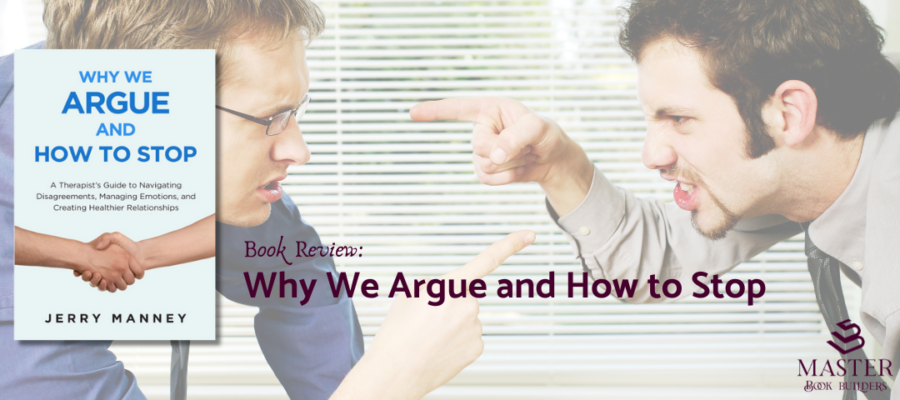Why We Argue and How to Stop – A Book for Managing Emotions
When I was asked if I’d like a copy of this book to review, I hesitated. I’d just had a fairly big argument with my husband, Tom, and I really wasn’t in the mood to be told what I could have done better to avoid the bad feelings that ensued. Of course, that is exactly why I said yes, send it along, I’ll read it.
The blurb on the back cover tells me that the author, Jerry Manney, is a therapist, writer, and teacher who is focused on helping people create better relationships by mastering their emotions and communication habits. You know I’m all about communication – it’s my belief that we all need to learn how to talk to each other more … appropriately? Certainly, more politely, sometimes.
This book promises to teach us how to:
- Transform damaging arguments into healthy disagreements
- Recognize when our emotions are taking over
- Take a step back and see things from the other person’s perspective
- Turn disagreements into fun and collaborative problem-solving exercises
But maybe the BEST advice of all is this: Manney tells us: you don’t have to go to every argument you’re invited to. Genius!
Anyone who knows me knows I highlight passages in books to return to, at later times. In this book, the first thing I highlighted in yellow was in the Introduction: “Think of this book as a toolkit.”
For those of us who want to do better, be better communicators, this toolkit is invaluable. Let’s unpack it.
Chapter One: Why We Argue. I won’t recreate the long-bulleted list, I’ll just note a few of the points he makes that spoke to me. One: we argue because we want to be right. Don’t deny it. You know you want to be right every time you’re in a disagreement.
Two: We argue as a form of competition. This one was interesting. Competing with the person you’re arguing with. Proving what, you’re smarter or better?
Three: We think if we repeat ourselves enough times, or say something loudly, the other person will finally get it!
Why We Argue and How to Stop has a questionnaire to access via the net to help us understand why we argue, so get the book and fill out the questionnaire. Then, write about it in your journal.
That’s another thing he urges us to do – keep a journal. I’m not big on that so I probably won’t do it. But I can see why and how it would help.

Overall, the book repeats much of what I already know about arguing and disagreements and my role in them. But there are gems to be gleaned.
In Chapter Two he writes: Vent with Someone Instead of at Someone. Be considerate. “Do you have a few minutes?” he asks us to say. “I need to tell someone about the lousy day I had.”
Chapter Four is where we get into the not attending every argument we’re invited to. I like that but it also confused me. Am I supposed to walk away or just nod my head and let the other person know I’m listening? I don’t quite know.
He does recommend trying to avoid being on the defensive. Oh, if only we could, right? But his comment,
“The reality is you’re human and you can only control 50 percent of any discussion: what you say and the manner in which you respond,”
is spot on. I believe in that 100%.
In other chapters we’re advised to “let go of anger and resentment” – he advises using positive self-talk. If only we could. I feel as if all therapists and mentors and coaches say, “Use positive self talk. Talk up how good you are. Tell yourself you’re beautiful.” And while you do all that, you’re thinking, “This is baloney.” Right? How do you over come that?
We should also “let go of excessive guilt” – sometimes it’s good to be the first one to apologize.
In conclusion, his very last chapter is the best of all: What to Do When You Need More Help. Invaluable in describing the kinds of things that might require outside help.
I appreciated the way this book was written and how it flowed.
Why We Argue and How to Stop: the bottom line
This book is for all humans who recognize the need to learn better communication, to save relationships that may be floundering in disagreement, to be open to the idea of learning more about themselves via the journaling and Moving Forward tasks Manney provides.
I leave you with the most valuable part of the book – from Chapter 5: Positive Communication is mutually empowering, and also contagious. It has seven guidelines:
- Be brief
- Be positive and non-confrontational
- Refer to a specific behavior
- Label your emotions
- Offer an understanding statement
- Accept partial responsibility
- Offer to help
Why We Argue and How to Stop is available through TCK Publishing and on Amazon.
Jerry Manney is a therapist, writer, and teacher focused on helping people create better relationships by mastering their emotions and communication habits.
Sign up for Jerry’s newsletter here.





Leave a Reply